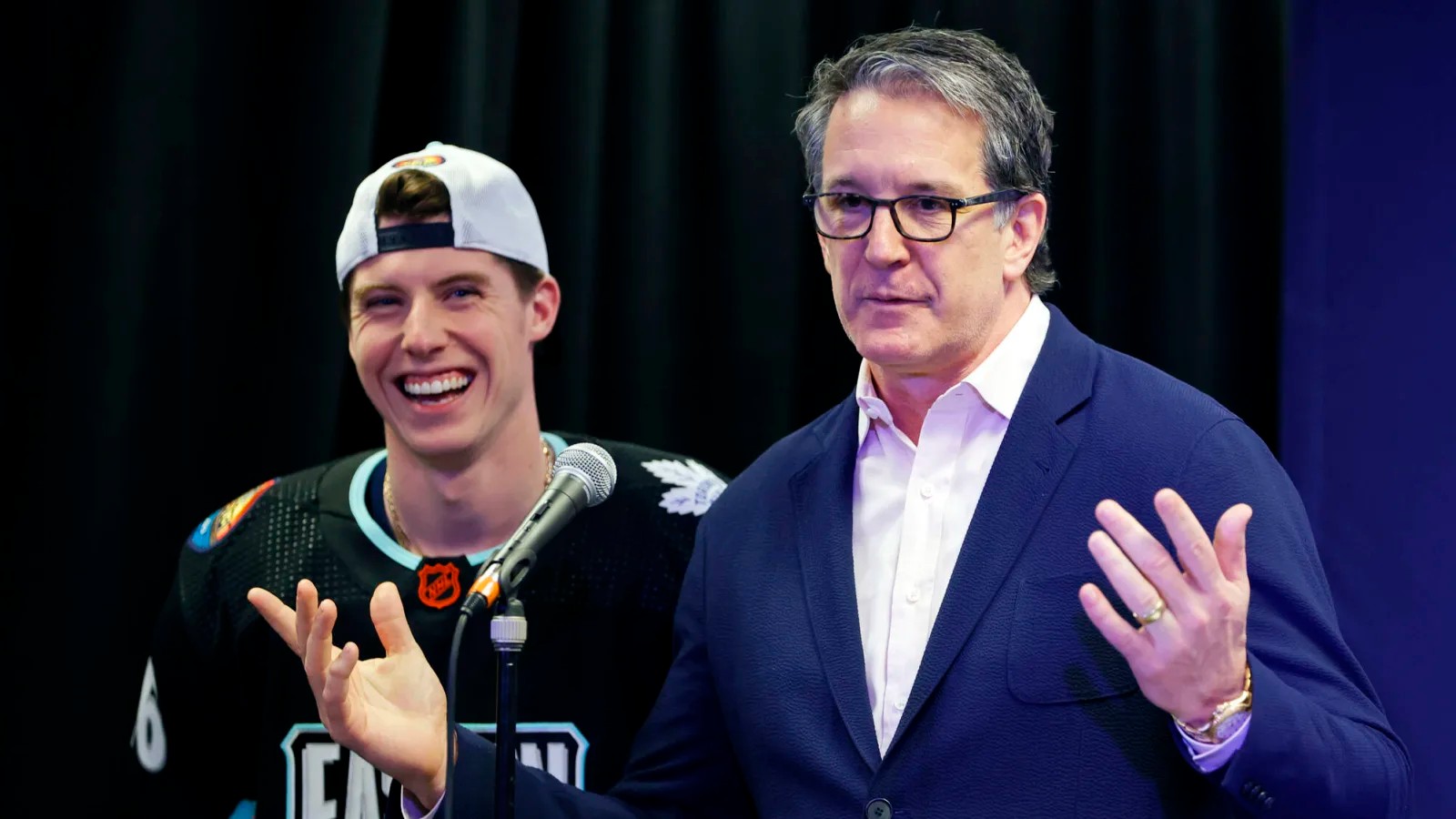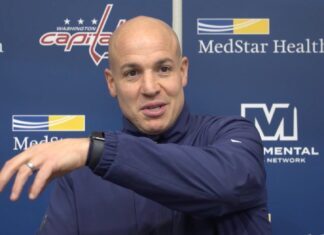“The challenge here in Toronto is not coming up with the plan. The challenge in Toronto is sticking to it.”
Those were Brendan Shanahan’s famous words when he was hired as Leafs President and set out to rebuild the ailing, storied franchise. For an organization that had been stuck in the mud for a decade at the time, it was critical to put a plan in place and stick to it in order to climb out of the basement and ascend the standings.
They have mostly done that, making the playoffs for eight straight years. But when you make the playoffs eight straight years and all you have to show for it is one playoff series win, it isn’t about sticking to a long-term plan anymore; it’s about being honest about where the organization stands in the here and now.
This is a perennial playoff team—and very few teams in the league can say that—but to this point, they haven’t been good enough to make a playoff run of consequence. Similarly, other than the “Canadian division” shortened season, they haven’t been good enough to win a division title or realistically compete for the President’s Trophy.
While regular-season success is often disregarded in this market, it should be questioned why such a strong team has never been able to ascend the standings and position themselves to play a 2024 Washington Capitals type of team or win the division and earn home-ice advantage. By the end of November this past season, a Bruins team in transition and a Florida team missing two of their three best defensemen had already comfortably positioned themselves ahead of the Leafs in the standings while Toronto punted a collection of games against bottomfeeders.
Since drafting Auston Matthews, the Leafs have the third-most points in the league overall, but they have never actually finished in the top three (though they did finish fourth twice). Over the years, they have been compared to many historical examples of franchises that took a long time to break through in the postseason, like the 2010s Washington Capitals or the 1990s Detroit Red Wings. The Capitals and Red Wings both won the President’s Trophy two years in a row before winning the Cup.
For all the talk about a mentally broken Leafs team, the need for a culture change, or whatever narrative suits your fancy, the reality is that they have yet to put together a complete team that is elite in all facets of the game. This is why they have yet to finish at the top in the regular season, and when the playoffs roll around, those deficiencies are exploited.
The Leafs bank on four elite forwards to drive the bus to overcome the flaws – and in the regular season, it works – but they simply have not been good enough to overcompensate for those issues in the playoffs. They must sort through not only why their key players haven’t been good enough when it matters (and what to do about it) but also identify the areas needing improvement and address them beyond “get ___ player off the team.”
After taking a few days to digest the series against the Bruins – one I think the Leafs would have won if they were as healthy as Boston was – there are a few issues that stand out, in no particular order:
– The defense defended well but lacked skill and struggled to move the puck in transition/provide offense from the point.
– They couldn’t score again (two goals or less in 13 of the last 14 playoff games), partly due to injuries – not an excuse; it’s the truth.
– Stability, or a lack thereof, in net
– Poor special teams across the board
Each issue is going to need to be evaluated and addressed.
Offense from the Defense
On defense, there were very few impact offensive plays from Leafs defensemen in the series. Jake McCabe scored—the only goal by a defenseman for the Leafs—while Morgan Rielly had one assist of note (throwing the puck in front from the boards that went off Tyler Bertuzzi and in). If we’re generous, we could maybe lump in Joel Edmundson joining the rush and giving the Leafs a 3v2, resulting in a Marner-to-Knies goal. In seven games, that’s the sum total of it.
Early in the series, the Leafs generated a ton of offense—as Sheldon Keefe noted, they led the playoffs in slot shots—but the Bruins eventually collapsed to take that away, leaving the points wide open. The Leafs’ defense didn’t do anything to make Boston regret that decision.
The inclusion of Timothy Liljegren in the lineup added a right-handed shot and presumably some skill to the back end, but he went the entire series without recording a shot on goal. Part of it was also Morgan Rielly playing below his usual playoff standard. This was the first time he failed to score a goal in the playoffs in six years. He generally wasn’t dangerous offensively throughout the series. Possibly more concerning, he often looked slow (and we haven’t been informed of any notable injury he was playing through or imminent surgery).
Rielly has also played with Luke Schenn and Ilya Lyubushkin as his primary partners in the last two playoffs. Those are solid, right-handed NHL defensemen, but they are not top-of-the-lineup players. At what point do they focus on finding Rielly a partner of consequence to set him up for real success?
Rielly also needs additional support offensively. McCabe was a pleasant surprise with eight goals and 28 points this season (both career highs), but the Leafs need another difference-maker with the puck. Every team remaining in the playoffs has at least two defensemen who qualify as one, and – in most cases – they possess an elite number-one defenseman. The Leafs have neither.
Next season, the Leafs already have all of Rielly, McCabe, and Benoit under contract. Conor Timmins is signed, too. They clearly need an injection of quality right-handed defensemen.
Center depth
While the defense and scoring go hand-in-hand, the forwards must wear these struggles more than anyone else. Their big guns not producing is the most concerning matter; they need their stars to be stars when the lights shine the brightest.
The Leafs have patiently waited for these players to break through and finally get the job done, and while they have shown flashes of it, they haven’t taken over as expected. Matthews and Nylander produced, health permitting, while Marner is an entirely different story we will discuss separately (it’s worthy of a novel). The Leafs are not going anywhere without their stars living up to their name. Plain and simple.
The second part of the lack of offense up front is the lack of center depth. John Tavares tallied two points in seven games, David Kampf had one, and Pontus Holmberg had zero. Those were the Leafs’ three primary centers behind Matthews. Max Domi recorded one assist playing center because he won the faceoff before McCabe scored.
Other than when Matthews was healthy, they had nothing going up the middle of the ice throughout the series. Matthews’ line with Bertuzzi and Domi was effective before it was broken up due to injury circumstances. When Nylander returned and got his legs underneath him, he produced as expected. Matthew Knies stepped up in the playoffs and was a young difference-maker to be excited about. There are good players who can be part of the solution, but they are all wingers. Championship teams are built down the middle.
Compounding the issue is the rapidly aging John Tavares. Last playoffs, TJ Brodie really struggled – something we flagged, but the Leafs never adequately replaced his role/demoted him in the offseason. When he continued to struggle this season, it was a real problem for the team. They can’t make this same mistake with Tavares, and they should be well aware of it because they spent over a month with Domi as 2C, with Tavares centering the third line down the stretch. Tavares is still a productive player (29 goals and 65 points), but Father Time is undefeated, and they need to be prepared beyond Holmberg/Kampf/praying a rookie like Fraser Minten or Easton Cowan is an instant difference maker.
Goaltending
Clearly, Joseph Woll is a very talented goalie, but he needs to prove he can stay healthy, something he hasn’t done at this point in his career. The most Woll has played in a single pro season is 32 games, which came all the way back in 2019-20. He was hurt twice this season on two routine plays for an NHL goalie. At this point, the Leafs can’t be confident that he is anything more than a very good backup goalie who can become a starter if he can ever handle the workload.
Ilya Samsonov rebounded well in the second half, but his play was generally a rollercoaster, and he understandably (from his perspective) desires term on his next deal. Even if the Leafs did sign him, all their question marks in net would remain in place.
Consider that the team was 24th in five-on-five save percentage this season and finished 10th overall in the league. Even improving to a league-average team in net would result in a notable jump up the standings. It still rings true: The Leafs won one playoff series in this era, and it was the only series where they had the better goalie. They need a real solution here.
It should be noted that Martin Jones is also a UFA and was rock solid in his role this season. If the team can retain him as the third-string goalie again, they should.
Special Teams
Last but not least, special teams is arguably the single biggest reason the Leafs are not still playing hockey.
It’s unfathomable that they went 1/21 on the power play. They kept running out the usual top-unit players despite the lack of production, and they kept running the same breakout despite the Bruins clearly learning the book on it. At the end of the day, the Leafs got what they deserved here.
Even with Matthews and Nylander missing at various points, they had more than enough talent to be credible on the man advantage, and they didn’t come close. That’s four out of the last five years where the power play has significantly dropped off in the playoffs under Sheldon Keefe. This is reaching a point where they should consider adding a power-play specialist, which is almost crazy to say out loud, considering the talent at their disposal.
Problems with the penalty kill have not been a common theme under Keefe in the playoffs, but this year, it was an issue they were seemingly never able to address all season. Throughout the regular season, Keefe bemoaned the lack of penalty killers among their group and the need to manufacture options (he tried basically everyone on the roster on the penalty kill at one point or another). Only the New York Islanders had a worse penalty kill among playoff teams this season. The Bruins weren’t just scoring; they scored goals that I would describe as easy finishes.
Special teams are the biggest indictment of the coaching staff. The power play is an annual problem in the playoffs, and the penalty kill was a problem all season, but at least Dean Chynoweth can argue that it’s the first season it was ever really an issue under his watch.
Both units require a deeper look than I’m going to provide in this piece, but both need tweaks strategically and personnel-wise. The penalty kill, in particular, did not have reinforcements brought in last offseason after players like Alex Kerfoot and Justin Holl left the team (and both were legitimately good PKers). Management can’t make the same mistake again.
Adjusting the Shanaplan
When it comes to winning next season, I’ve identified the four areas where the Leafs need to improve. They would have likely beaten the Bruins if they had been better in just one of these areas. But the goal isn’t to beat the Bruins and win one round; it’s to win the Stanley Cup. They really need to look at the bigger picture and take the proper steps to shore up these critical areas. Simply relying on their top players to plow through it is not the answer.
They need more talent on defense, particularly right-handed defensemen. They need to add quality down the middle, find a starting goalie, and sort out their special teams. They already have 10 forwards, four defensemen, and a goalie signed for next season, with roughly $20 million in cap space. Is that going to be enough to fill all of those holes?
In previous years, whether the Leafs had the cap space to address their needs or not, they would bargain-bin shop and look to plug their holes on the cheap around their top players. When the chips are down in the playoffs every spring, their stars have shown time and time again that they will not overcome the shortcuts taken around them on the roster by outscoring the problems. That’s how they’ve been built, but it simply hasn’t worked.
First and foremost, the Leafs brass need to be honest about this reality, and then they need to figure out how to address those needs. That might involve moving a star and his salary to make space. It might mean trying to swap a forward of consequence for a defenseman or goalie of consequence. It might mean simply moving some of their mid-salary forwards for the necessary cap space.
The challenge isn’t setting the plan and seeing it through anymore. It’s about adjusting with an honest recognition of its shortfalls.















![John Gruden after the Leafs prospects’ 4-1 win over Montreal: “[Vyacheslav Peksa] looked really comfortable in the net… We wouldn’t have won without him” John Gruden, head coach of the Toronto Marlies](https://mapleleafshotstove.com/wp-content/uploads/2025/09/gruden-post-game-sep-14-218x150.jpg)


















